Abstract
The hydraulic performance of rectangular labyrinth weirs has been investigated by many researchers, however, the effects of the corner shape on the hydraulic performance of rectangular labyrinth weirs have not been addressed in the current literature. Accordingly, this experimental study aims to explore the effect of the corner shape of on discharge efficiency of rectangular labyrinth weirs. Five flat-crested rectangular labyrinth weirs, with five different corner shapes, were made of High-Density Polyethylene Plastic (HDPE) and tested in a rectangular flume. Under different overflow discharges, the discharge coefficients for the rectangular labyrinth weirs were determined. The results showed that the shape of corners for rectangular labyrinth weirs was an effective factor. For example, rounding or beveling the corners can significantly increase the discharge capacity of the rectangular labyrinth weirs. However, the rounded corner shape was slightly better than the beveled corner shape. Among all labyrinth weir models tested in this study, the rectangular labyrinth weir with a semi-circular apex showed the highest hydraulic efficiency, while the one with an acute-angle corner shape showed the lowest hydraulic efficiency. For the rectangular labyrinth weir having a semi-circular shape, although the original effective length reduced by about 14%, the discharge coefficient, CL, increased by 16.7% on average. For the rectangular labyrinth weir that has an acute-angle corner shape, although the effective length (LC) of the weir increased by 23%, its discharge capacity decreased by 35.2% on average. Accordingly, improper folding of the side-walls of the rectangular labyrinth weir led to a significant reduction in the weir’s hydraulic performance.
1. Introduction
An effective and economical way to increase the spillway discharge capacity at a dam, without increasing the existing spillway channel width and/or water heads over the crest, is constructing a labyrinth weir [1,2,3,4,5,6,7,8]. A labyrinth weir is a weir that has a crest length that is longer than a given channel or spillway width [4,9]. It is typically constructed by placing linear weirs in a zigzag pattern, folded in the plan view. Therefore, since it is usually constituted by repeated in plan-view simple shapes (cycles), such as U-shape (half-circular shape), circle-shape (sinusoidal shape), V-shape (triangular shape), rectangle (rectangular shape), and trapezoid (trapezoidal shape) shapes, both the design and construction of labyrinth weirs are very cost-effective [2,5,10,11].
The labyrinth weirs have many advantages such as: discharging larger floods; storing a larger volume of water in reservoirs; simplicity regarding the construction; cost-effectiveness concerning construction and maintenance; and preferability concerning aeration and energy dissipation [5,6,7,8,12,13,14,15].
The factors that govern the performance of labyrinth weirs are discharge, head, and weir geometry [7,12]. The factors that control the weir geometry are the total crest length of the weir (effective crest length), LC; cycle width, w; sidewall angle, α; upstream wall height, P; downstream wall height, D; wall thickness, T; crest shape; and weir apex shape (apex configuration or weir tips shape) that is horizontally normal to the flow direction [2,5,12].
The discharge capacity for labyrinth weirs is typically increased, due to the increase in the crest length. However, as the crest length increases, the discharge coefficient of the labyrinth weirs decreases [4]. This, in turn, leads to a reduction in the discharge capacity of the labyrinth weirs. However, the increase that comes from the length is much larger than the decrease that comes from the reduction in the discharge coefficient. Accordingly, labyrinth weirs are hydraulically more efficient compared to linear weirs. This is true especially at low upstream total heads; as the upstream total heads increase, the hydraulic efficiency of the labyrinth weirs decreases [4].
One of the labyrinth weir types that has excellent structural and economical characteristics is the rectangular labyrinth weir [10,16]. The rectangular labyrinth weir is a labyrinth weir that has a right angle (90 degrees) between two adjacent weir sides; the weir tips (apexes) are perpendicular to the sidewalls [7], see Figure 1. However, similar to triangular and trapezoidal labyrinth weirs, the rectangular labyrinth weir has nappe collision problems (nappe interferences). The nappe interference occurs where the water sheets flowing over two adjacent walls collide. This, in turn, reduces the discharge efficiency of the labyrinth weirs [4]. For rectangular weirs, the nappe interface can occur at the upstream corners; due to colliding of flow sheets coming from the upstream apex (tip) and sidewalls. This, in turn, can reduce the discharge efficiency of the rectangular labyrinth weirs. It is believed that improving their corner shapes can reduce or eliminate the nappe interference problem for rectangular labyrinth weirs; increase their hydraulic efficiency.
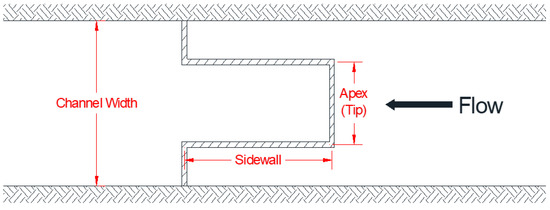
Figure 1.
A typical sketch of a rectangular labyrinth weir.
The hydraulic performance of rectangular labyrinth weirs has been studied by many researchers [7,9,10,15,16,17,18,19]. In the current literature, the effects of corner shapes on the hydraulic efficiency of rectangular labyrinth weir have not been addressed. Accordingly, the purpose of this study is to explore the effect of the labyrinth weir corner shape on the labyrinth weir’s discharge capacity. If the shape of the rectangular weir corners is modified or changed from sharp to round or beveled shapes, how much more discharge can be passed with the same head? With this aim, the present study was carried out.
2. Experimental Works
To study the effects of corner shapes on the discharge coefficient of labyrinth weirs, six experimental models, fabricated from High-Density Polyethylene Plastic (HDPE) with 1 cm thickness, were installed in a laboratory flume at the University of Sulaimani. Figure 2 shows a photograph of the experimental setup (S6MKII—Teaching and research flume—manufactured by Armfield company) that comprised an inlet tank, main channel, outlet tank, reservoir tanks, pump, pipes and valves, and flowmeter. The length, width, and height of the main channel were 5 m, 0.3 m, and 0.45 m, respectively. The models were placed at the mid-length of a zero-slope steel bed flume with Plexiglas sidewalls. The flat crest shape rectangular labyrinth weir models (five models) were placed in the flume in an inverse orientation and tested without an artificial aeration device. Figure 2 and Figure 3 and Table 1 present the details of the models studied in this research.
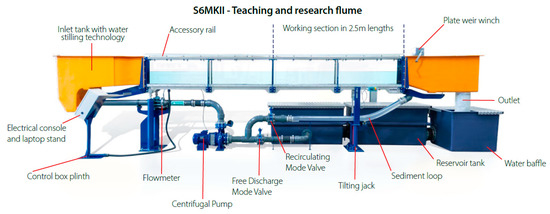
Figure 2.
Armfield S6-MKII laboratory flow channel.
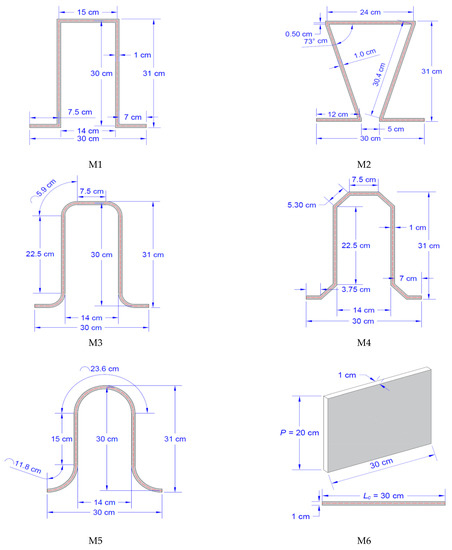
Figure 3.
Plan views of the weir models used in this investigation.

Table 1.
Characteristics of the weir models.
The tests were carried out for steady and free overflow conditions under flowrates between 1 and 30 L/s. Table 2 presents some details about the experimental runs carried out in this study. The flow rates were measured using an ultrasonic flowmeter flow. The flow depths over the crest of the models were measured using a point gauge with 0.1 mm accuracy. For each model, visual observations, digital-photo taking, and video-recording were used during each test for 3 to 4 hours to document the hydraulic performance.

Table 2.
Detail of the experimental runs.
3. Analysis of Results
This experimental study is based upon the results of six models: five labyrinth weirs and one linear weir. The discharge coefficients for the flowrates over the models were computed using Equation (1) [12,20]. The equation, a standard form of the weir equation that expresses the head-discharge relationship, is expressed as follows:
where Q is the flow rate over the labyrinth weir, g is the acceleration constant of gravity, CL and CB are the dimensionless discharge coefficients, LC is the centerline length of the weir crest or effective length of the weir crest (the centerline length of the weir crest), B is channel width, and HT is the total head on the crest of the models, see Figure 4.
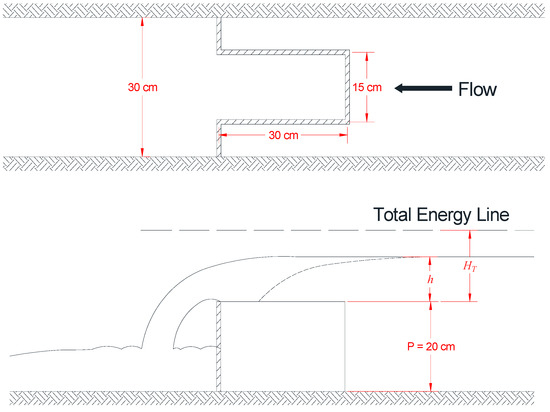
Figure 4.
Schematic diagram of flow over rectangular labyrinth weir including flow parameters.
HT is defined as:
where h is the vertical distance from the weir crest to water surface upstream of the weir, and Va is the approach (average cross-sectional) velocity for the flow upstream of the weir.
The unit discharges, q, were plotted against HT/P in Figure 5, Figure 6, Figure 7 and Figure 8. Additionally, the computed values of the discharge coefficient (CL) were plotted against HT/P, as shown in Figure 9, Figure 10, Figure 11 and Figure 12. A comparison between the hydraulic performances of the models was made as shown in Table 3 and Table 4.

Figure 5.
Variation of discharge capacity (q) versus HT/P for all physical models.

Figure 6.
Comparison of discharge performance for M1 and M5 models.
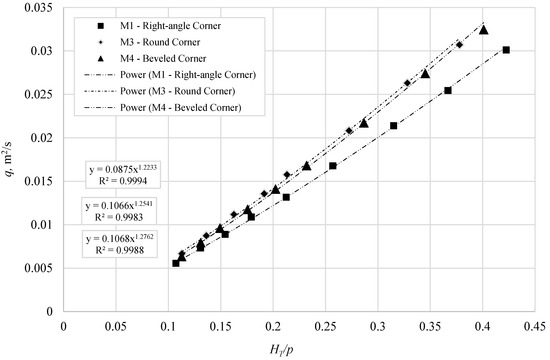
Figure 7.
Comparison of discharge performance for M1, M3, and M4 models.
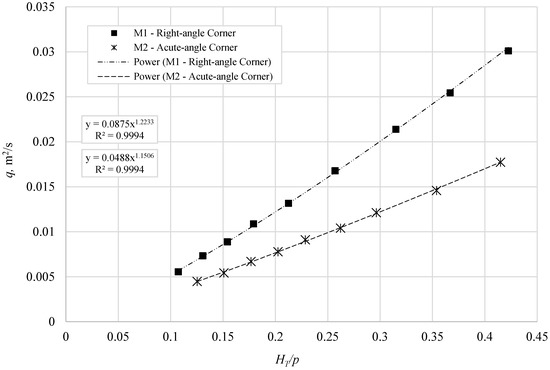
Figure 8.
Comparison of discharge performance for M1 and M2 models.
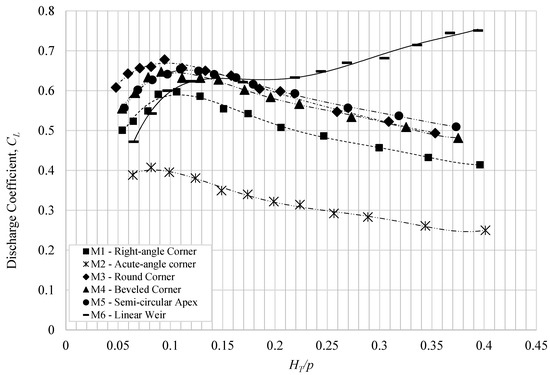
Figure 9.
Variation of discharge coefficient (CL) versus HT/P for all physical models.
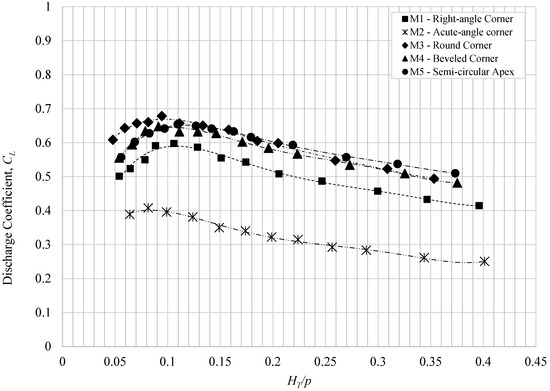
Figure 10.
Discharge coefficient (CL) versus HT/P for M1, M2, M3, M4, and M5 models.
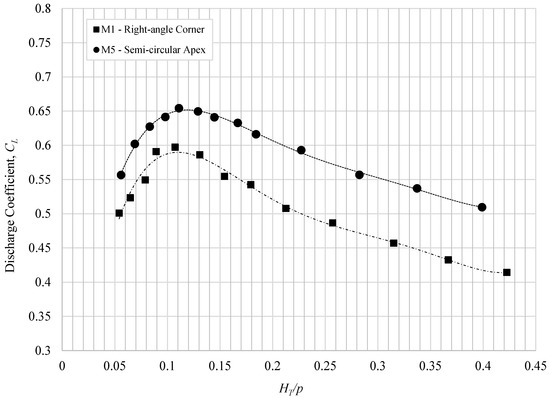
Figure 11.
Discharge coefficient (CL) versus HT/P for M1 and M5 models.
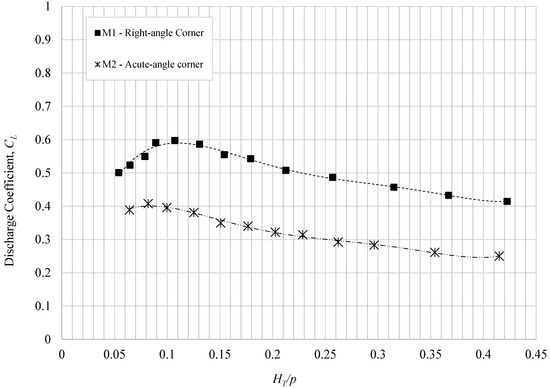
Figure 12.
Variation of discharge coefficient (CL) versus HT/P for M1 and M2 models.

Table 3.
Percentage changes in the unit discharge due to the corner shapes.

Table 4.
Percentage changes in the discharge coefficients due to the corner shapes.
3.1. Hydraulic Performance of the Models
From the results, as the water depth over the weirs increased, the discharge increased for all weirs; however, for similar water depths, the hydraulic efficiency of some weirs was better than other weirs, see Figure 5. For the discharge range used in this study, although the effective length (LC) of some models decreased, their ability to pass discharge increased. Among all labyrinth weir models, the one with a semi-circular apex (M5 model) showed the highest hydraulic efficiency, while the model with an acute-angle corner shape (M2 model) showed the lowest hydraulic efficiency.
To quantify the experimental results, a regression analysis was performed between the unit discharge over the weirs, q, and the HT/P values. The best-fitting correlation shows the power trend as follows:
The values of a and b, as well as R2, are given in Table 5. Additionally, to compare the models to each other, the rectangular labyrinth weir model (M1 model) was selected to be the reference model. A quantified comparison among the labyrinth weir models was then made, as shown in Table 6.

Table 5.
Parameters of the regression analysis for unit discharges.

Table 6.
Parameters of the regression analysis of discharge coefficients.
From Figure 6 and Table 3, although its effective length (LC) decreased by 14%, the unit discharge (q) over the M5 model, compared to the M1 model, increased by 19% on average; the range of increase in the q values was 14.5–24.4%. This finding is in agreement with the literature [9] that compared a U-shape labyrinth weir to a rectangle shape labyrinth weir and found that the U-shape labyrinth weir had a higher discharge coefficient.
From Figure 7 and Table 3, For the rectangular labyrinth weir with a round corner shape (M3 model), although the effective length reduced, the discharge capacity of the model increased. The values of the q for the M3 model increased by 15.3 (on average); the values of the increased q ranged from 13.5% to 18.4%. For the labyrinth weir model having a beveled corner shape (M4 model), the hydraulic performance of the M3 model was slightly better than that of the M4 model. The hydraulic performance of the M3 and M4 models was decently higher than that of the M1 model. For the M3 and M4 models, the percentages of discharge capacity increases are 15.3 and 12%, respectively, as shown in Figure 7 and Table 3.
From the results of the M2 and M1 models, as depicted in Figure 8, although the effective length (LC) of the M2 model increased by 23%, its discharge capacity, compared to the M1 model, decreased by 35.2% on average; the range was from 34.1 to 40.4%. The reduction in the discharge capacity of the M2 model might be due to the susceptibility of the model to the early interference of the falling nappe at the downstream apex, see Figure 13. Additionally, as higher water depths over the weir increased, the inadequate space of the M2 model at the downstream apex restricted the flow from the upstream apex of the model towards the downstream apex. This, in turn, created a rooster tail at the downstream end of the weir, see the right upper corner of the photo in Figure 14.
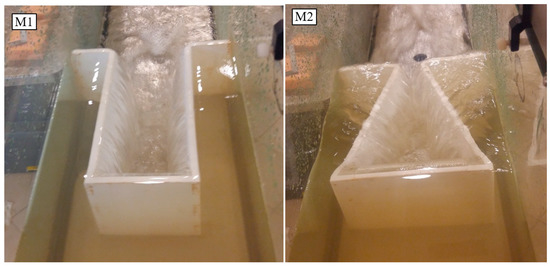
Figure 13.
Flow condition for M1 and M2 models; Q = 0.00375 m3/s for M1 model, and Q = 0.00365 m3/s for M2 model.
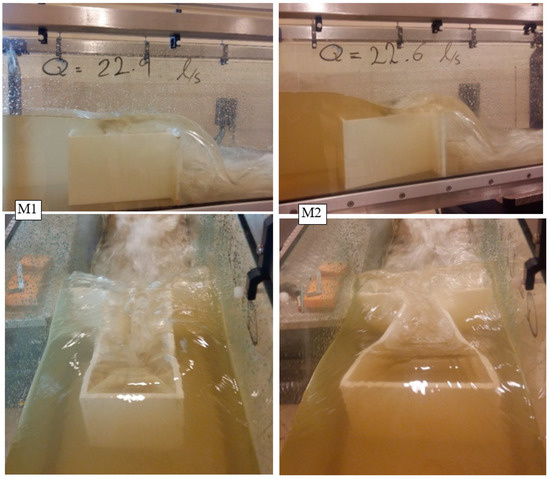
Figure 14.
Flow characteristics for M1 and M2 models, Q = 0.0226 m3/s for M1 model, and Q = 0.0229 m3/s for M2 model.
3.2. Effect of Corner Shape on the Discharge Coefficient
The results of the experiments show that the corner shape has significant effects on the discharge coefficients of the rectangular labyrinth weirs. For the discharge range used in this study, although the effective length of the models (LC) used in this study decreased, except for the M2 model, the values of CL for some models increased significantly. On the contrary, the values of CL for the M2 model decreased significantly, even though the effective length of the model was larger compared to the length of the M1 model. Furthermore, the CL values of the M1 model were smaller than those of the models having either round corners (M3 model) or beveled corners (M4 model). Figure 9, Figure 10, Figure 11 and Figure 12 show the values of CL for the models that are plotted as a function of HT/P ratios. As depicted, the results showed that the values of CL for the labyrinth models increased with an increasing HT/P ratio until a specific value of HT/P, after which a constant decrease in CL value occurred.
To formulate the experimental results, a regression analysis was performed. The best-fitting correlation between the values of CL and HT/P shows the 5th-degree polynomial trend as follows:
The values of a0 to a5, as well as R2, are given in Table 6. From the results, the important effect of corner shape on the CL could be seen in the range from 0.05 to 0.4 of HT/P. The results showed that the corner shapes increased the CL values by 9.9% to 41.6%, see Table 4.
From the results depicted in Figure 9, the variation of CL values could be divided into three parts. For small discharges, HT/P < 0.1, the CL values for the labyrinth weirs (M1, M2, M3, M4, and M5) were higher than those of the linear weir (M6). While for HT/P > 0.17, the CL values for the linear weir (M6) were higher than those of the labyrinth weirs (M1, M2, M3, M4, and M5). This can be attributed to the fact that the labyrinth weirs typically create larger headwater inflation, compared to the linear weirs. This, in turn, leads to an early reduction in CL values for labyrinth weirs at small discharges, for HT/P < 0.1 [4,10]. However, for small discharges (HT/P < 0.17), due to the longer effective length of the labyrinth weirs (LC), the effect of the headwater inflation was smaller for rectangular labyrinth weirs compared to the linear weir. As discharge increased at a higher head (HT/P > 0.17), due to headwater inflation, as well as nappe interaction and interferences, the CL values for the linear weir were higher than those for rectangular labyrinth weirs. The decrease in CL values for labyrinth weirs occurs due to the nappe interaction, which increases as discharge increases [10].
From Figure 10, for all labyrinth weirs, the specific value of HT/P, after which the value started to decrease, was about 0.1. The water depths at which the CL values are maximum, the water depths of flows over labyrinth weirs at which the self-aerating terminates [10]. Those water depths observed in this study were very close to 10% of the weir height (P).
The effect of the headwater inflation of rectangular labyrinth weirs can be reduced by using different corner shapes. The CL values for rectangular weirs can be increased by using a round or beveled corner shape instead of a right-angle corner shape. For the discharge range used in this study, in the range from 0.05 to 0.4 of HT/P, changing the corner shape from the right-angle shape (M1 model) to either a round or beveled shape (M3 and M4 models) increased the CL values by 16.6% and 13% (on average), respectively. However, in the range from 0.30 to 0.4 of HT/P, the changes in the CL values for the M3 and M4 models (compared to the M1 models) were similar.
The apex shape of the labyrinth weir was effective as well. For the labyrinth weir with a semi-circular shape (M5 model), although the original effective length reduced by 14%, the CL values increased by 16.7 on average; the CL values increased by 9.9% to 22.8%, see Table 4 and Figure 11.
Due to early and high jet interference effects, formed because of the corner shape, the hydraulic efficiency of the M2 model reduced greatly; it was even lower than the linear weir, see Table 4 and Figure 12. The results showed that the CL values of the M2 model reduced by 21.4 to 42.6%; 36.5% on average. The reduction in CL values of the M2 model might be due to the susceptibility of the model to early the interference of the falling nappe at the downstream apex, see Figure 13 and Figure 14. This led to smaller values of CL, which in turn led to a decline in the discharge capacity. In other words, improper folding of the side-walls of the labyrinth weir led to a significant reduction in the weir’s hydraulic performance.
4. Conclusions
The effects of the corner shape on the hydraulic performance of flow over rectangular labyrinth weirs have been investigated experimentally. Five different corner shapes were studied using six experimental models. The discharge coefficients for the rectangular labyrinth weirs were determined under different overflow discharges. The results show that the crest shape is one of the important factors that affect the discharge capacity for rectangular labyrinth weirs. In other words, the hydraulic performance of the rectangular labyrinth weirs can be significantly improved by modifying the corner shapes or the apexes. However, improper folding of the side-walls of the rectangular labyrinth weir leads to a significant reduction in the weir’s hydraulic performance. The test results also showed that rounding or beveling the corners can significantly increase the discharge capacity of the rectangular labyrinth weirs. However, the rounded corner shape was slightly better than the model with the beveled corner shape. Furthermore, changing the apex of the rectangular labyrinth weir from a flat apex to a semi-circular apex increased the discharge capacity of the model by about 19%. However, for the rectangular labyrinth weir that had an acute-angle corner shape, although the effective length (LC) of the weir increased by 23%, its discharge capacity decreased by 35.2% on average.
Author Contributions
Conceptualization, O.S.Q.Y.; methodology, O.S.Q.Y.; formal analysis, O.S.Q.Y.; investigation, O.S.Q.Y.; resources, O.S.Q.Y.; writing—original draft preparation, O.S.Q.Y.; writing—review and editing, M.K.; visualization, M.K.; supervision, M.K.; project administration, M.K. All authors have read and agreed to the published version of the manuscript.
Funding
No fund has been granted for this research.
Acknowledgments
The authors are very grateful to the College of Engineering at the University of Sulaimani for allowing us to use the experimental facility in the Hydraulic laboratory.
Conflicts of Interest
The authors declare no conflict of interest.
References
- Anderson, R.M.; Tullis, B.P. Piano Key Hydraulics and Labyrinth Weir Comparisons. J. Irrig. Drain. Eng. (ASCE) 2013, 139, 246–253. [Google Scholar] [CrossRef]
- Bilhan, O.; Emiroglu, E.; Miller, C.J. Experimental investigation of discharge capacity of labyrinth weirs with and without nappe breakers. World J. Mech. 2016. [Google Scholar] [CrossRef]
- Crookston, B.M. Labyrinth Weirs. Ph.D. Thesis, Utah State University, Logan, UT, USA, 2010. [Google Scholar]
- Crookston, B.M.; Tullis, B.P. Labyrinth weirs: Nappe interference and local submergence. J. Irrig. Drain Eng. 2012, 138, 757–765. [Google Scholar] [CrossRef]
- Jansen, R.B. Advanced Dam Engineering for Design, Construction, and Rehabilitation; Springer Science & Business Media: Berlin/Heidelberg, Germany, 1988. [Google Scholar]
- Khode, B.V.; Tembhurkar, A.; Porey, P.; Ingle, R. Determination of Crest Coefficient for Flow over Trapezoidal Labyrinth Weir. World Appl. Sci. J. 2011, 12, 324–329. [Google Scholar]
- Taylor, G. The Performance of Labyrinth Weirs. Ph.D. Thesis, University of Nottingham, Nottingham, UK, 1968. [Google Scholar]
- Tullis, P.; Amanian, N.; Waldron, D. Design of labyrinth spillways. J. Hydraul. Eng. 1995, 121, 247–255. [Google Scholar] [CrossRef]
- Anderson, R.M.; Tullis, B.P. Comparison of piano key and rectangular labyrinth weir hydraulics. J. Hydraul. Eng. 2012, 138, 358–361. [Google Scholar] [CrossRef]
- Azimi, A.H.; Hakim, S.S. Hydraulics of flow over rectangular labyrinth weirs. Irrig. Sci. 2019, 37, 183–193. [Google Scholar] [CrossRef]
- Safarrazavi Zadeh, M.; Esmaeili Varaki, M.; Biabani, R. Experimental study on flow over sinusoidal and semicircular labyrinth weirs. ISH J. Hydraul. Eng. 2019, 1–10. [Google Scholar] [CrossRef]
- Houston, K. Hydraulic Model Study of Ute Dam Labyrinth Spillway; Rep. No. GR-82-7; U.S. Bureau of Reclamations: Denver, CO, USA, 1982.
- Falvey, H.T. Hydraulic Design of Labyrinth Weirs; ASCE: Reston, VA, USA, 2003; p. 162. [Google Scholar]
- Lux, F.; Hinchliff, D. Design and construction of labyrinth spillways. In 15th Congress ICOLD; Vol. IV, Q59-R15; ICOLD: Paris, France, 1985; pp. 249–274. [Google Scholar]
- Wormleaton, P.R.; Tsang, C.C. Aeration performance of rectangular planform labyrinth weirs. J. Environ. Eng. 2000, 126, 456–465. [Google Scholar] [CrossRef]
- Kabiri-Samani, A.; Javaheri, A.; Borghei, S.M. Discharge coefficient of a rectangular labyrinth weir. Proc. Inst. Civ. Eng.-Water Manag. 2013, 166, 443–451. [Google Scholar] [CrossRef]
- Emadi, A.R.; Rezaei, M. Experimental study of rectangular labyrinth weirs. J. Water Soil (Agric. Sci. Technol.) 2015, 29, 1438–1446. [Google Scholar]
- Heidarour, M.; Mousavi, S.F.; Zarmehri, A.R. Investigation of rectangular and U-shaped labyrinth weirs. JWSS-Isfahan Univ. Technol. 2006, 10, 1–12. [Google Scholar]
- Rostami, H.; Heidarnejad, M.; Purmohammadi, M.H.; Kamanbedast, A.; Bordbr, A. An Experimental study into discharge coefficient of labyrinth weirs with rectangular-shaped plans. Fresen. Environ. Bull 2016, 25, 5138–5144. [Google Scholar]
- Henderson, F.M. Open Channel Flow (No. 532 H4); Macmillan: New York, NY, USA, 1966. [Google Scholar]
© 2020 by the authors. Licensee MDPI, Basel, Switzerland. This article is an open access article distributed under the terms and conditions of the Creative Commons Attribution (CC BY) license (http://creativecommons.org/licenses/by/4.0/).